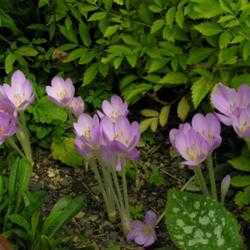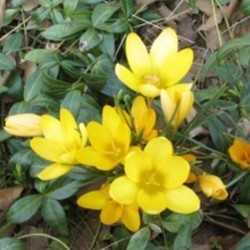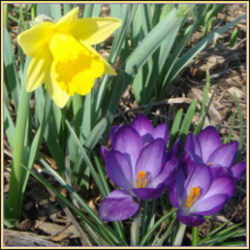(Editor's Note: This article was originally published on September 20, 2008. Your comments are welcome, but please be aware that authors of previously published articles may not be able to promptly respond to new questions or comments.)
Sally Miller (sallyg) wrote an article introducing us to the Dutch hybrid crocus and the Tommie crocus, C. tommassinianus. She ended her article stating that there are some 80 species of crocus. Crocus are certainly the harbingers of spring for most gardeners. Of course, they may be the harbingers of fall if you grow the fall-blooming types. You can refer to an article I wrote last year on those types of crocus. The purpose of this article is to introduce you to some of the other winter-spring blooming crocus that can be added to the standard Dutch hybrids and Tommies. Like those previous species, many of these are easy, carefree bulbs that will multiple year after year. I grow all my crocus in groups of at least a dozen for best impact. Nothing looks more lonely than a solitary crocus! It is important to allow them to die away naturally to build up reserves in the corms for future blooming. I grow them in my rock garden, among the perennials and naturalized in my lawn. Provide them with at least part sun and well-drained, reasonably fertile soil and they will reward you with some of the earliest blooms of the season. Having said this, there are some species that are quite difficult in cultivation, demanding hot baking in the summer in order to thrive. Gardeners in wetter, cooler areas many have trouble with these species. However, such crocus species are difficult to find at local nurseries so I will try to stick to the more readily available species.
To elaborate on the Dutch crocus, most of the purple and white hybrids have been derived from C. vernus. These hybrids include ‘Purpureus' (dark purple), ‘Remembrance' (silvery-purple), ‘Vanguard' (two-tone purple and silvery-lilac), ‘Snowstorm' (white), ‘Jeanne d'Arc' (white with purple base) and the various striped selections such as ‘Pickwick', ‘Striped Beauty' and ‘King of the Stripes'. Included in the Dutch hybrids is the golden-yellow hybrid called ‘Yellow Mammoth' which has C. flavus in its ancestry.




The more common Dutch hybrid crocus include 'Purpureus', 'Pickwick', 'Jeanne d'Arc', 'Remembrance' and 'Yellow Mammoth'
Among the named C. tommassinianus is ‘Ruby Giant' (dark purple, despite the cultivar name), ‘Whitewell Purple' (dark violet-blue), ‘Roseus' (silvery lilac flushed pink), ‘Barr's Purple' (light violet) and ‘Lilac Beauty' (lighter lilac-blue with silvery blue reverse).



Among the C. tommassinianus are 'Lilac beauty', 'Barr's Purple', 'Ruby Giant' and 'Whitewell Purple'
The Dutch crocus are among the last crocus to bloom while the Tommies are among the first. The rest fall somewhere in-between. There is one other very common group of crocus that bloom about the same time as the Tommies. These are often called the snow crocus or botanically, C. chrysanthus. There are many named selections and hybrids that fall under the umbrella of C. chrysanthus. The wild type has small golden-yellow flowers, not unlike a smaller version of the Dutch crocus called ‘Yellow Mammoth'. Among the hybrids, the snow crocus come in a multitude of colours, often with exquisite stripes on the outer side of the petals. Many times these are sold as mixed colours, but better nurseries will sell them by separate varieties. Some of the common ones include ‘Ard Schrenk' (white, subtle purple flush on outer petals), ‘Snow Bunting' (white, purple outer stripes), ‘Miss Vain' (pure white), ‘Blue Bird' (white flushed pale blue), ‘Skyline' (pale blue with darker blue stripes on outer petals), ‘Prins Claus' (white with dark purple on outer petals), ‘Lady Killer' (much the same as ‘Prins Claus'), ‘Blue Pearl' (light blue), ‘Princess Beatrix' (light blue with purple-flushed reverse), ‘Romance' (golden with purple flush on outer petals), ‘Advance' (lighter version of 'Advance'), ‘Herald' (golden with purple reverse on outer petals), ‘Cream Beauty' (creamy yellow), ‘Saturnus' (golden with dark purple outer stripes), ‘Gypsy Girl' (golden with lighter purple stripes), 'Dorothy'(similar to ‘Gypsy Girl), ‘Fuscotinctus' (similar to Gypsy Girl), ‘Goldilocks' (golden with purple-bronze flush), and ‘E.P. Bowles' (similar to ‘Goldilocks').




Among the white to bluish C. chrysanthus are 'Ard Schrenk', 'Bluebird', 'Blue Pearl' and 'Prins Claus'






Among the yellow C. chrysanthus selections are 'Advance', 'Cream Beauty', 'Romance', 'Saturnus', 'Gypsy Girl' and 'Dorothy'
Another common species in the trade is C. sieberi. They bloom towards the tail end of the C. chrysanthus season. This species also comes as several named selections. The wild species is light lavender blue with a yellowish center. The named selections include ‘Violet Queen' (violet with deep yellow center), ‘Tricolor' (violet with deep yellow center and central white ring), ‘Bowle's White' (white with yellow center) and the most spectacular of all, ‘Hubert Edelsten'(inner petals silvery-lilac, outer petals lilac feathered in deep purple).



Among the selections of C. sieberi are 'Violet Queen', 'Tricolor' and 'Hubert Edelsten'
The following are some other crocus species sometimes found in the trade. Crocus ancyrensis is golden yellow and not unlike a smaller version of ‘Yellow Mammoth'. Crocus etruscus is lilac with darker purple stripes on the reverse of the petals. It is one of my favorites which I accidentally acquired as mislabeled C. minimus, which, in itself, is an exquisite silvery-lilac crocus with dark purple stripes. Other delightful species which are a little trickier as they need summer baking, are C. biflorus (lavender-blue), C. angustifolius (golden with purple striping on the reverse of the outer petals) and C. versicolor (white with dark purple stripes on the reverse of the petals).







Other crocus species that are reasonably easy in the garden are C. minimus, C. biflorus, C. etruscus, C. versicolor, C. ancyrensis and C. angustifolius
If you check out specialty bulb nurseries, you may indeed find a host of other species, but remember that if they are not common in the trade, it means they may be more challenging in cultivation. Even with the few species I mention in this article, you can be rewarded with a wonderful display of late winter-early spring blooms, a prelude to even better things to come!
I would like to sincerely thank ladyrowan for her pic of Crocus ancyrensis and zcebeci for his pic of Crocus angustifolius.
















